Ducati Superleggera V4 Test by Adam Child ‘Chad’
Images Milagro and Ducati
Dry weight is 159 kg, a colossal 16 kg weight saving over the standard V4 Panigale. Peak power is 224 hp in standard road trim, or 234 hp with the supplied race exhaust/kit. The race kit removes road mirrors, number plate etc and drops the weight further to 152.2 kg. Despite its V4 Stradale motor revving to 16,500rpm, and capable of lapping just over two-seconds slower than an Italian Superbike around Mugello, service intervals are at a perfectly normal 12,000 kilometres and it’s a normal homologated road bike.

Don’t be misled into thinking this is ‘just’ a Panigale with a race pipe and big wings. No, this is an entirely new bike from the ground up. It is, for starters, the world’s only homologated bike with a carbon chassis (which saves 1.2 kg over the standard bike). Carbon wheels account for another 3.4 kg saving. Even with its homologated power output of 224 hp, that’s enough to give the it record-breaking power to weight ratio of 1.41 hp/kg.
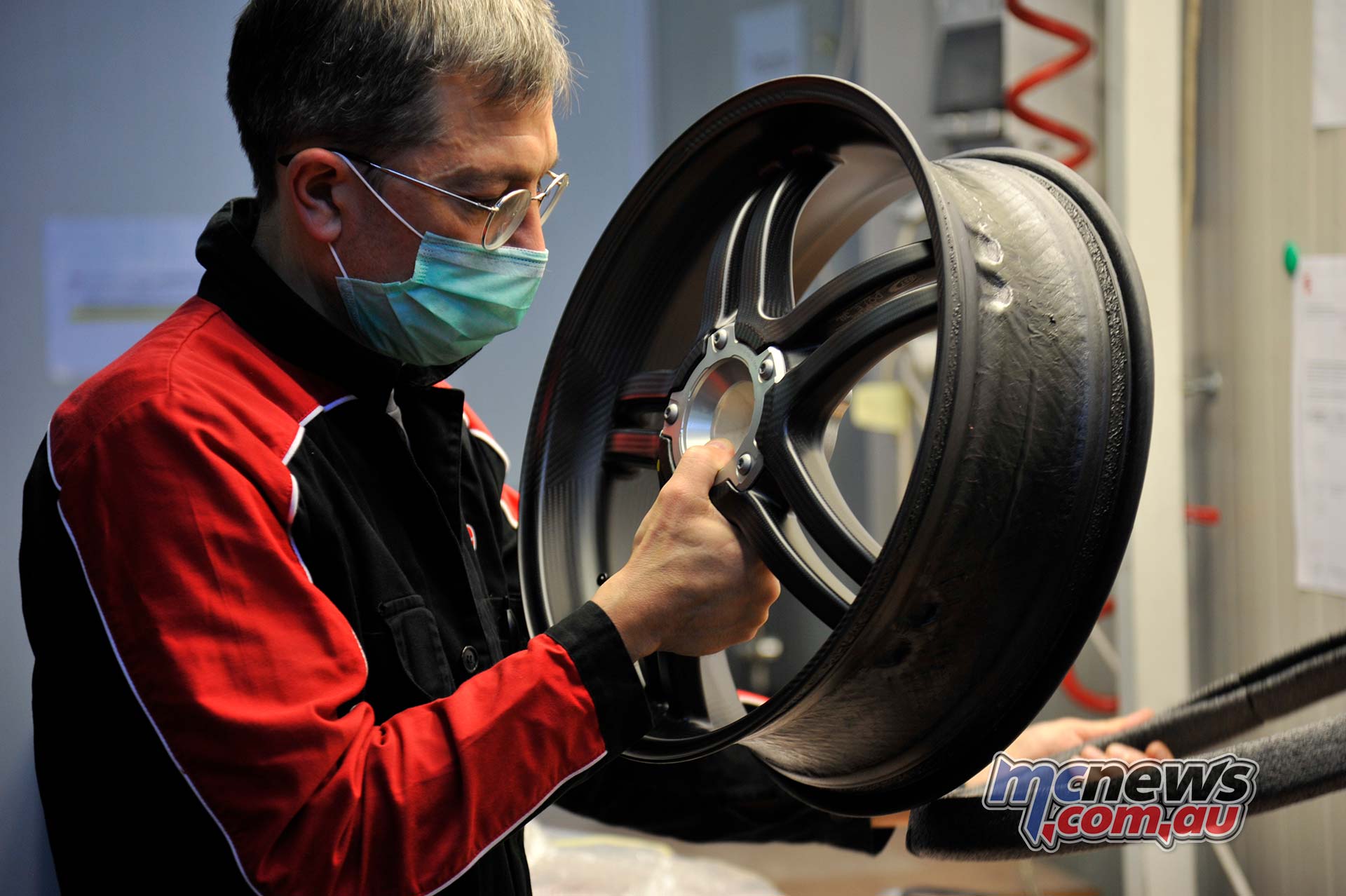
Let’s chat about the huge bi-plane wings. The exclusive and, I would say, attractive wings are fascinating and directly derived from MotoGP. Back in 2016, there weren’t any restrictions in the size and shape of the wings, which means the GP16, Ducati’s last MotoGP bike before downforce-curbing regs were introduced, had the most effective wings of all time. In fact, the downforce created by the Superleggera is higher than the GP20, a bike that must conform to strict regulations on wing size.

At 167 mph the wings are claimed to produce 50 kg of downforce, 20 kg more than the current Panigale with its single wing. At 186 mph that’s up to 61 kg, more weight than Dani Pedrosa in race leather – enough to improve stability and reduce wheelies, therefore allowing better acceleration, braking and corner entry.

The electronics package is brand-new since simply transferring the electronics from the current Panigale R to the lighter, more powerful, extra downforce Superlegerra wouldn’t work. As you’d expect, it gets the full range of goodies: cornering ABS, slide control, traction control, anti-wheelie, launch control, an up and down quick-shifter, and changeable engine braking strategies. Rider aids can be trimmed and changed to meet personal demands while Ducati has also added three additional new rider modes, simply A, B, and Sport – two are track specific, the third for the road. There’s also a new RaceGP dash mode, for track use only, which shows your lap times, splits, and riders aids. Pre-programmed tracks are already saved, like Mugello, so you can simply work on improving your lap time and splits.
Riding the Superleggera V4
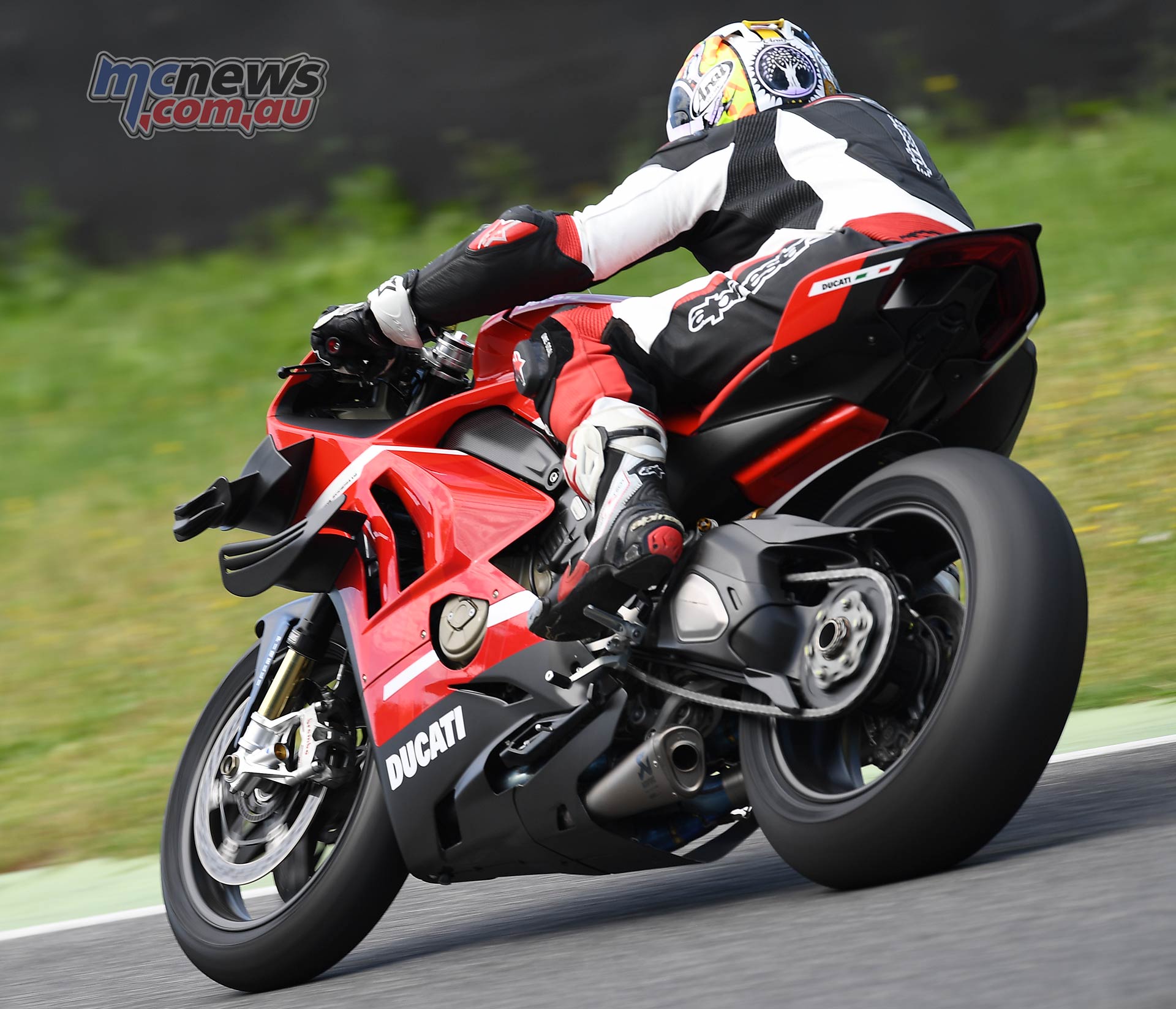
Once out of pit lane the clutch is now needless as I fire in a few quick gear-changes towards turn one. The bark between fast gear changes sounds like a gun going off and echoes around the historic grandstand.
It’s over 30-degrees out here and the Pirelli slicks have been scrubbed and then cooking on warmers, so there’s no need to take it steady. Immediately the carbon-chassis of the Superleggera wants to turn, feeling light, accurate, and fast steering. Out of turn five, I’m recalibrating to sheer intensity of the V4’s power and torque, yet only tickling the throttle.
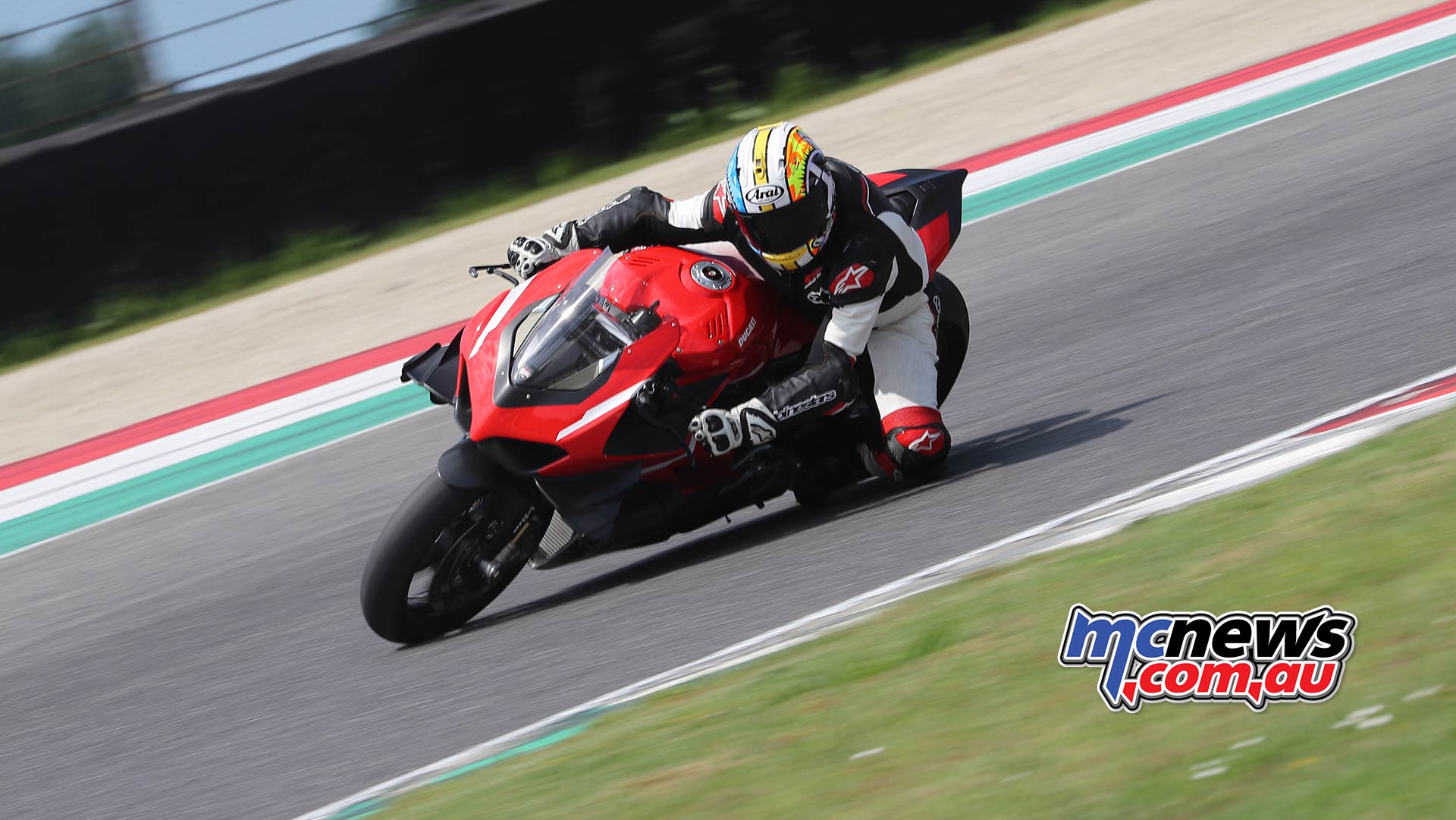
This Ducati might have the power of the factory’s WSBK contender, or near as damn it, but it’s usable and smooth. I’m a little rusty from the enforced lay-off due to the plague and braking and accelerating at the wrong points, but the bike is allowing me to do so without a hint of complaint.
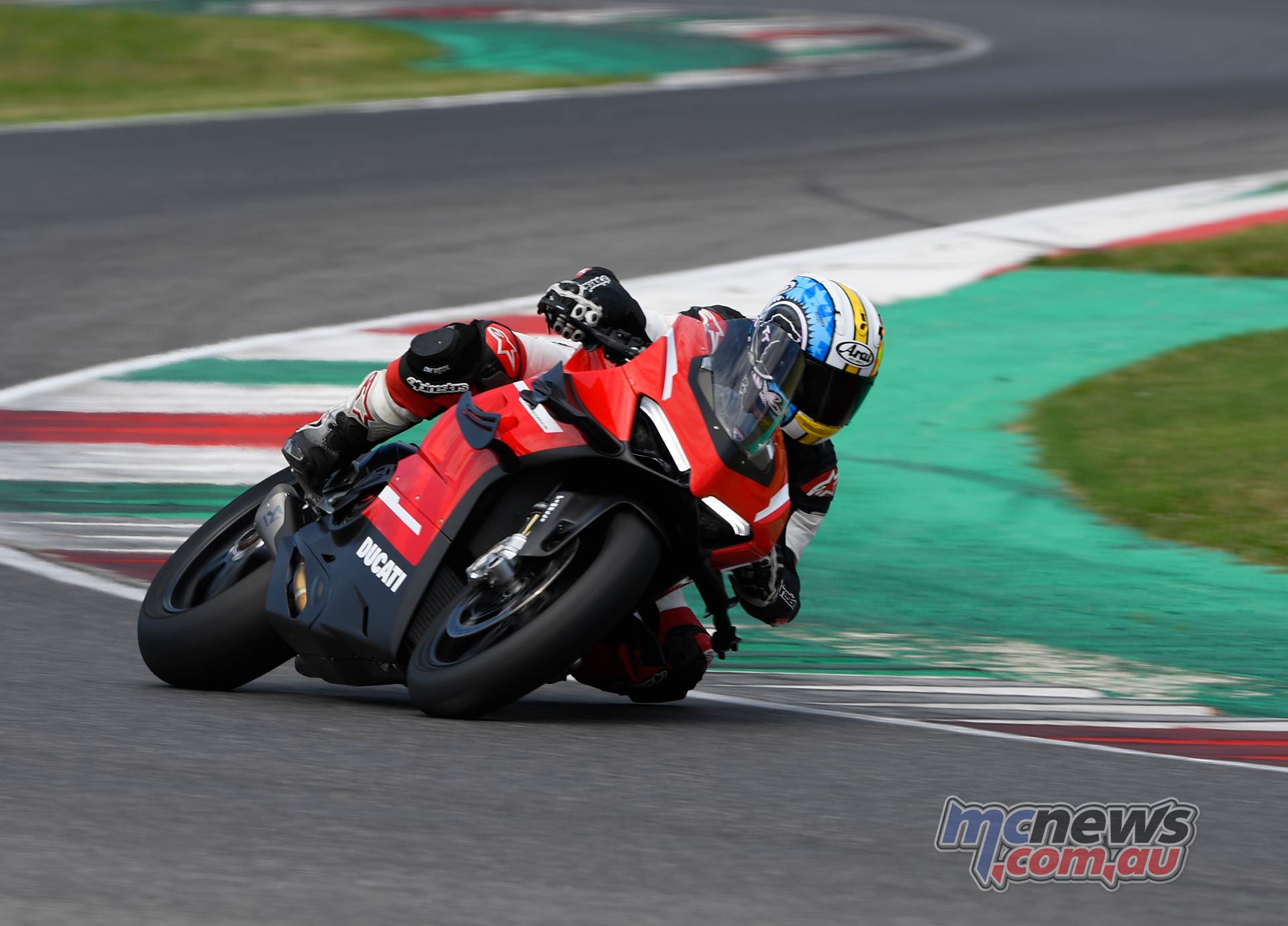
On the long straight I tuck in behind the sizable screen, tap the gears, push my arse up against the bump stop and revel in the ride. The liquid smooth Stradale motor loves to rev, while upshifts are almost seamless and incredibly quick. Each flick of the left foot slaps me in the head with another tidal wave of power. Yes, Mugello is over five-kilometres long but has never felt so short or so fast.

I start to gel with bike and circuit but despite getting into the flow and really starting to make the engine shout, the front end remains planted. In my chosen race B riding mode there’s no hint of a wheelie or instability and it feels more like playing an Xbox game.
Mugello is wide and open but still the Superleggera shrinks it to the size of a car park. Now I’m only changing gear when the shift lights illuminate, but in no time at all I’m in fifth gear and tap into top before that notorious blind rise of Mugello. Fast bikes get notably flighty over the crest, some even weave as the suspension extends, but the winged Superleggera is rock-solid and clearly loving those 60-odd kilos of winged downforce.
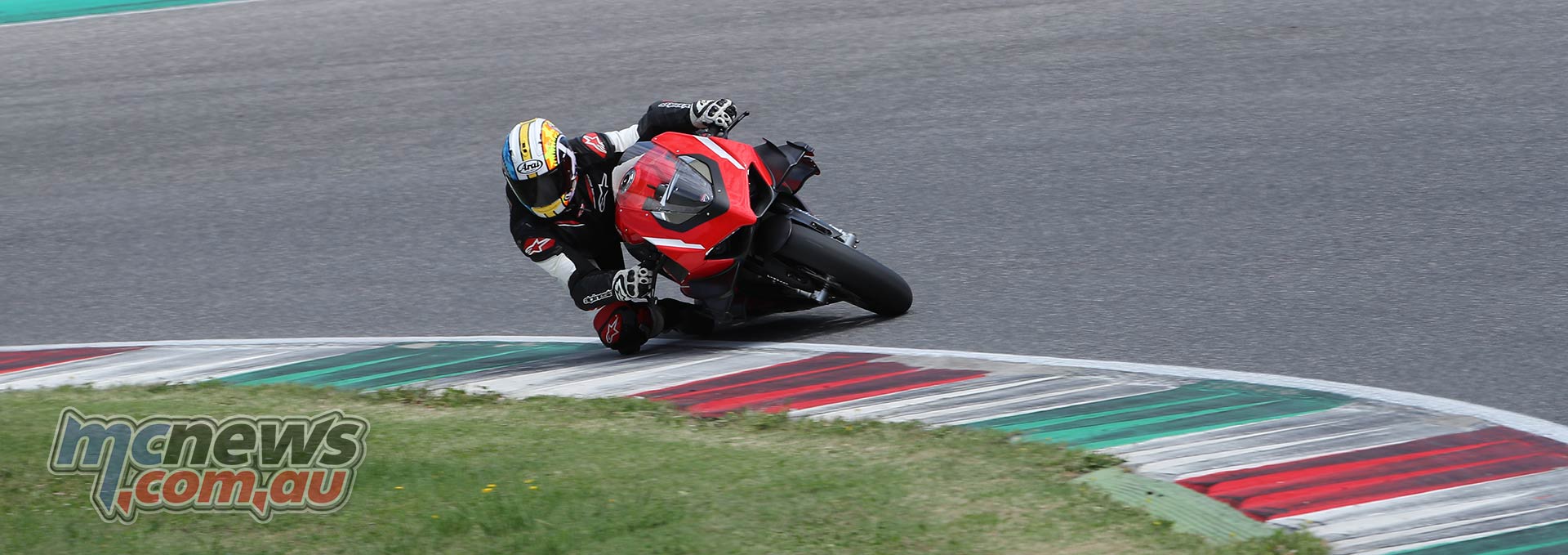
Then hard on the brakes into turn one and back down the gears. The Brembo Stylema R calipers grab the 330mm discs like a dog holding onto his favourite stick, yet the forks take the strain, and again the stability is faultless. The limiting factor isn’t the brakes but the rider. I don’t know of any other bike that can brake this late and remain so planted.
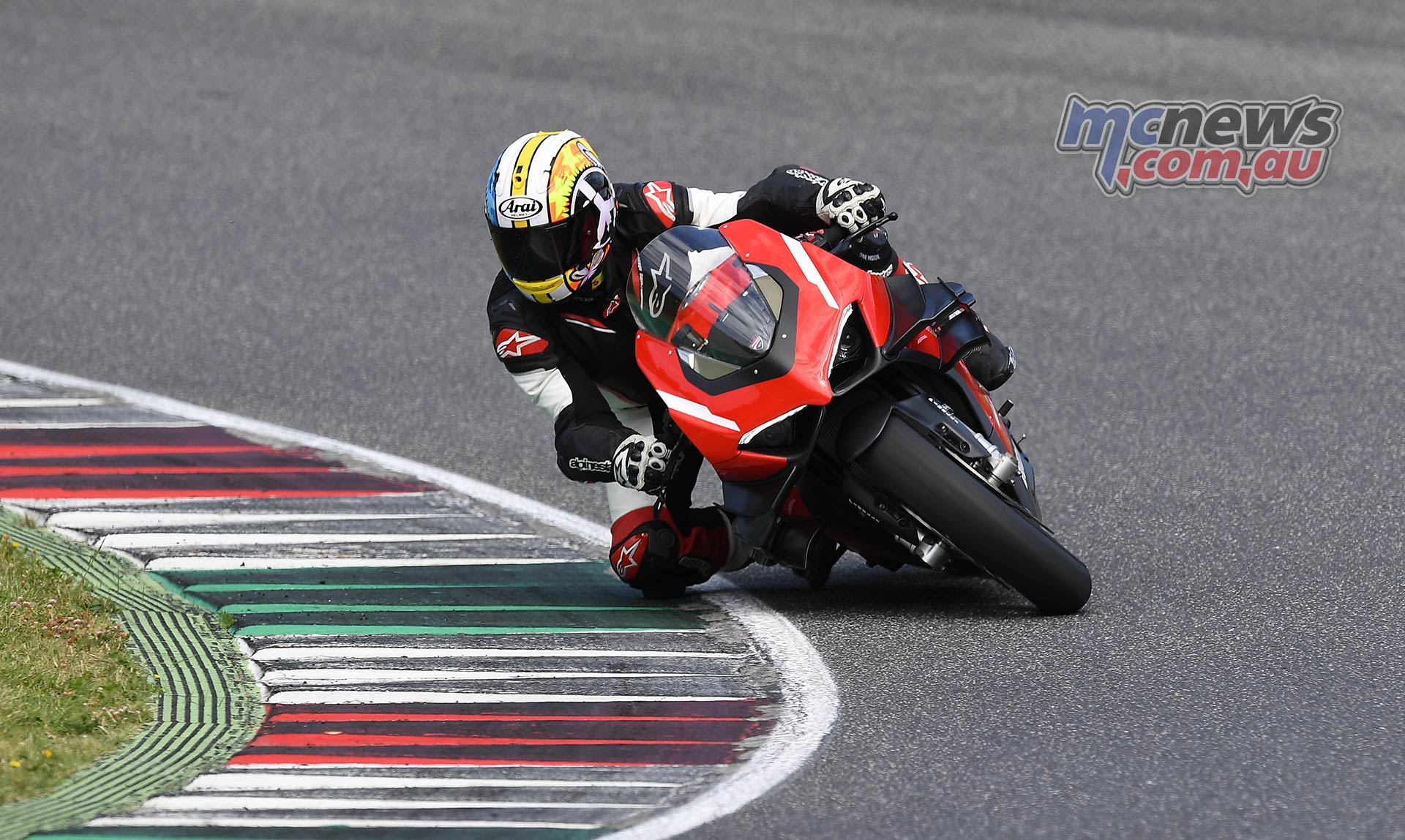
The wings are clearly adding to this stability, but so is the carbon fire chassis, which now has more flex and feel than before. Everyone knew this Superleggera was going to be fast, after all the figures stand out for themselves, but like the braking, I didn’t expect the handling to be so far ahead of the game.
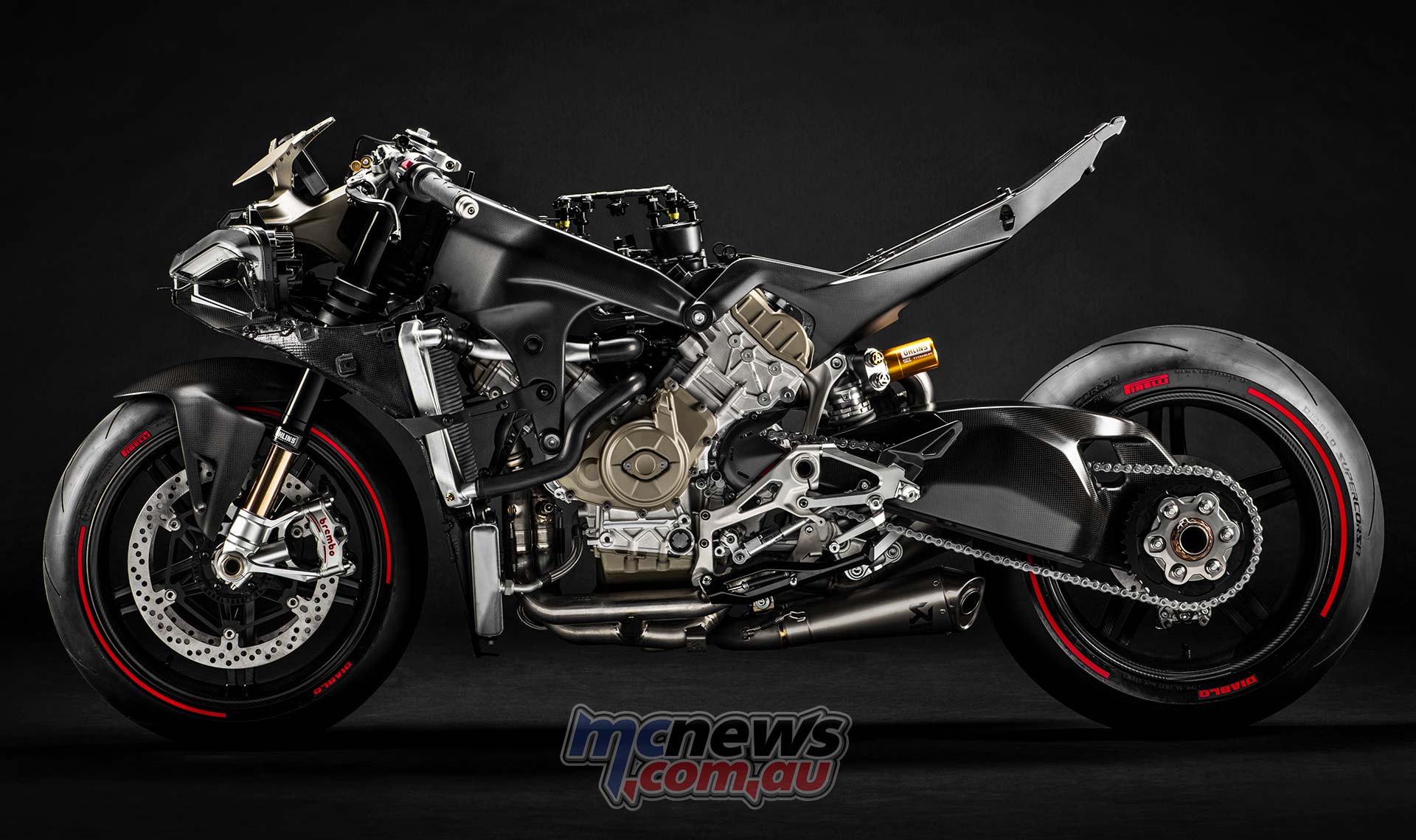
I’ve ridden offensively powerful WSBK Ducatis before and even congratulated Chaz Davies on the size of his testicles after sampling his animal Superbike at Imola a few years ago. This Superleggera, however, is incredibly forgiving and easy to ride considering its jaw-dropping power.
As my bravery and confidence improves, I opt to flick to A mode, which delivers full power and torque in the lower gears. To be fair, Mugello isn’t a wheelie-happy track (I only used first gear to leave pit-lane), but in this sharper mode there’s certainly more kick lower down. But again, the front is unflustered, only lifting slightly on the first application of throttle when the wings aren’t really working at low speeds.
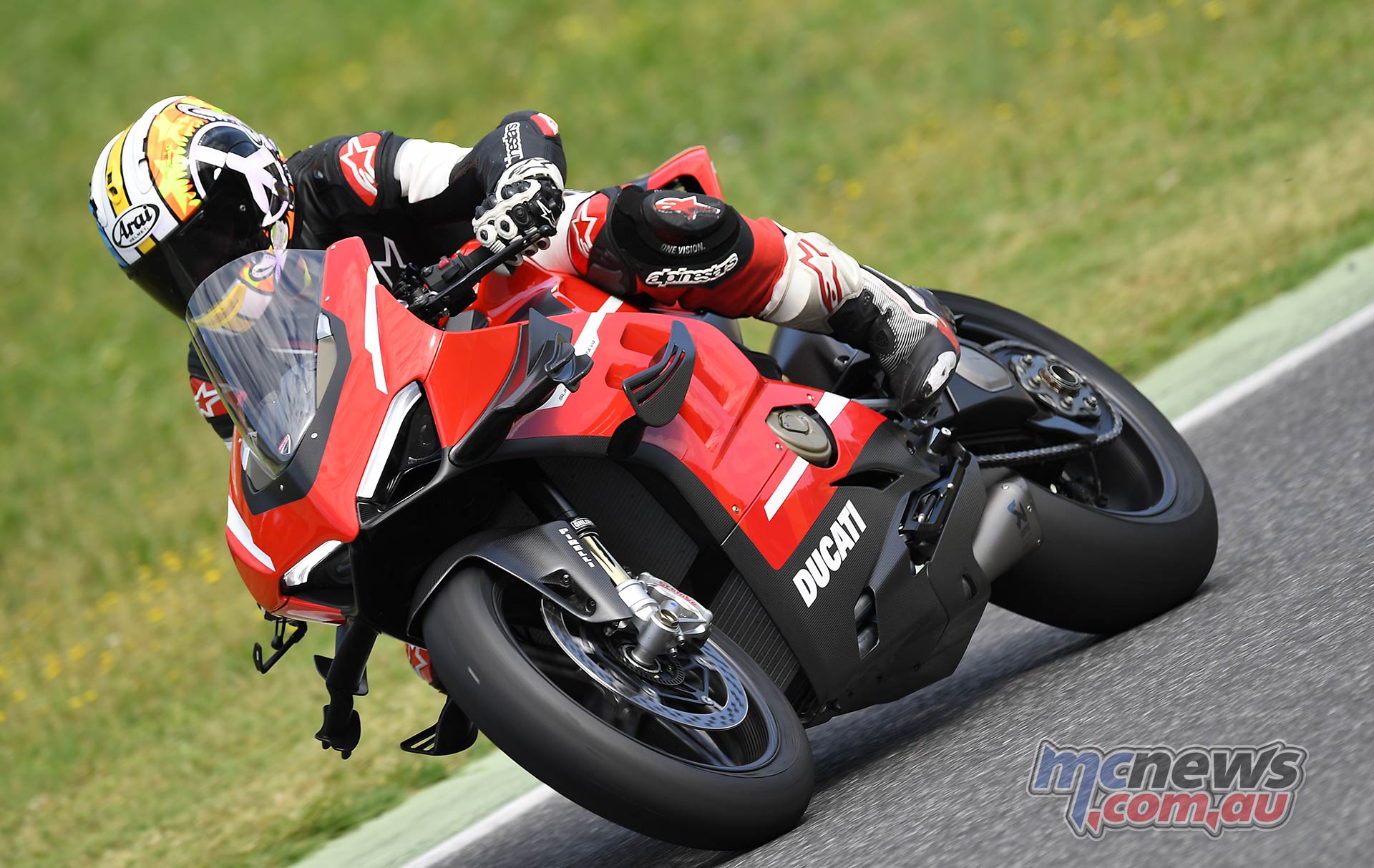
Verdict
Yes, it’s priced at $150,000 and Ducati are only making 500 of them. And, regrettably, some will never be ridden, on the road or track. But beyond these negatives I can’t find any faults. This is a genuine superbike for the road, a machine capable of lapping within a few seconds of a top-flight factory race bike and, incredibly, can be ridden on the road. However, I doubt we will ever see one on the road, as it will likely be the poster bike for the next generation, in the same way I had a poster of a Honda NR 750, next to Pamela Anderson.
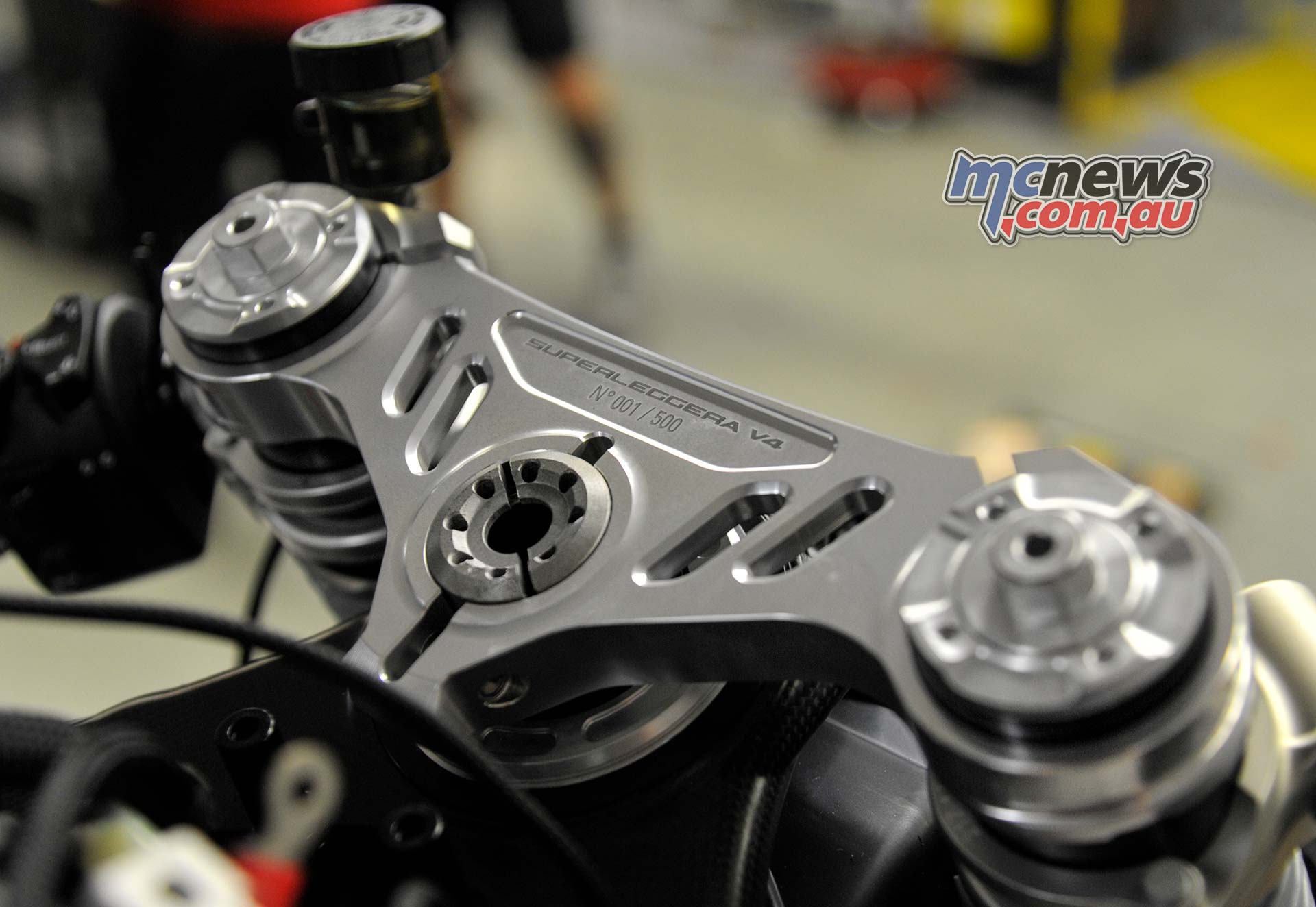
So you want to buy one?
I want one, where do a sign? For your $150,000 you don’t just get a motorbike. Oh no, new owners will have access to the ‘SBK Experience’ which allows them to ride the World Superbike Ducati around Mugello. Yes, included in the price, is a few laps of Mugello on Chaz or Scott’s work bike.
And yes the WSBK experience is of course available to Australian owners as well however due to the current COVID environment this experience has been postponed until 2021. The custom made leather suit and helmet are also available to Superleggera V4 owners in Australia.
Furthermore, if you want to splash out further, you can splash out another 50k and get to ride the actual Ducati Desmosedici GP20 MotoGP race machines as used by Petrucci and Dovizioso.
However, this is limited to just 30 applicants and you must be the ‘correct’ size. And if you really, really, really want to spend some money, Ducati is offering colour matching Dainese air-bag leathers, and a carbon-fibre helmet from Arai. If you’re going to cash in your pension, you might as well spend it all. ScoMo is going to have to up the limit for early superannuation withdrawals somewhat!
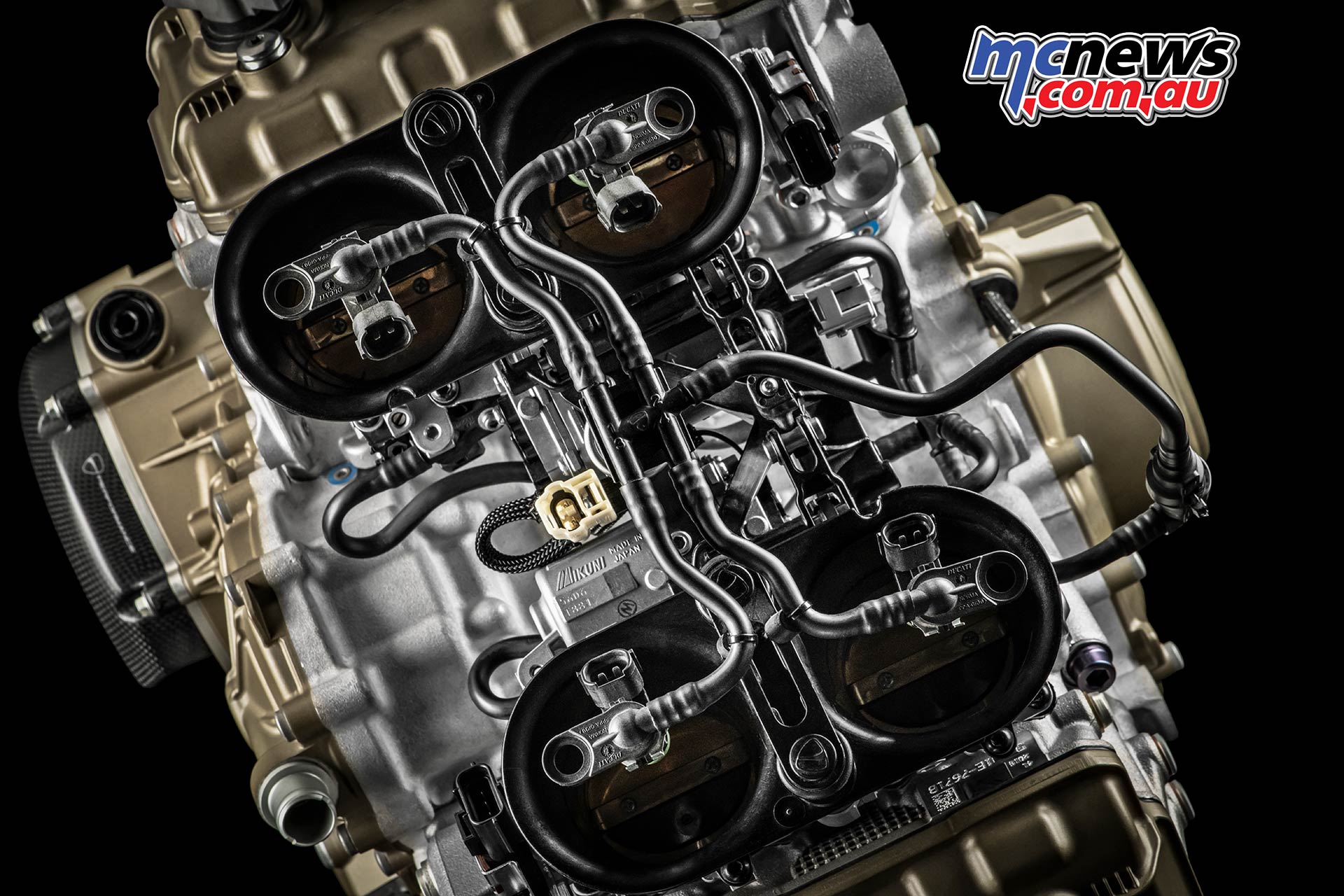
2020 Ducati Superleggera V4 Specifications
| Superleggera V4 | |
| Engine | |
| Desmosedici Stradale 90° V4, lightened, counter-rotating crankshaft, 4 Desmodromic timing, 4 valves per cylinder, liquid-cooled | |
| Displacement | 998 cc |
| Bore X stroke | 81 x 48.4 mm |
| Compression ratio | 14.0:1 |
| Power (EU homologation) | 165 kW (224 hp) @ 15,250 rpm – 174 kW (234 hp) @ 15.500 rpm with full racing exhaust |
| Torque (EU homologation) | 116 Nm (85.6 lb-ft) @ 11,750 rpm – 119 Nm (87.7 lb-ft) @ 11.750 rpm with full racing exhaust |
| Fuel injection | Electronic fuel injection system. Twin injectors per cylinder. Full ride-by-wire elliptical throttle bodies with aerodynamic valves. Variable length intake system |
| Exhaust | 4-2-1-2 system, with 2 catalytic converters and 2 lambda probes |
| Transmission | |
| Gearbox | 6 speed with Ducati Quick Shift (DQS) up/down EVO 2 |
| Primary drive | Straight cut gears; Ratio 1.80:1 |
| Ratio | 1=38/14 2=36/17 3=33/19 4=32/21 5=30/22 6=30/24 |
| Final drive | Regina ORAW2 chain ; Front sprocket 15; Rear sprocket in Ergal 42 |
| Clutch | Hydraulically controlled slipper dry clutch |
| Chassis | |
| Frame | Carbon fibre “Front Frame” |
| Front suspension | Fully adjustable 43 mm Öhlins NPX25/30 pressurized fork with TiN treatment, billet fork bottoms, lightweight springs, fully adjustable. |
| Front wheel | 5 split-spoke carbon fibre 3.50″ x 17″ |
| Front tyre | Pirelli Diablo Supercorsa SP 120/70 ZR17 |
| Rear Suspension | Fully adjustable Ohlins TTX36 unit with GP valve and titanium spring. Carbon fiber single-sided swingarm. |
| Rear Wheel | 5 split-spoke carbon fibre 6.00″ x 17″ |
| Rear tyre | Pirelli Diablo Supercorsa SP 200/60 ZR17 |
| Wheel travel (front/rear) | 120 mm (4.7 in) – 130 mm (5.1 in) |
| Front brake | 2 x 330 mm semi-floating discs, radially mounted Brembo Monobloc Stylema R 4-piston callipers with Cornering ABS EVO |
| Rear brake | 245 mm disc, 2-piston calliper with Cornering ABS EVO |
| Instrumentation | Last generation digital unit with 5″ TFT colour display |
| Dimensions/Weights | |
| Dry weight | 159 kg (350 lb) – 152.2 kg (335.5 lb) with racing kit |
| Seat height | 835 mm (32.9 in) |
| Wheelbase | 1.480 mm (58,3 in) |
| Rake | 24,5° |
| Front wheel trail | 100 mm (3,94 in) |
| Fuel tank capacity | 16 l |
| Number of seats | Single seat |
| Safety equipment | |
| Riding Modes, Power Modes, Cornering ABS EVO, Ducati Traction Control (DTC) EVO 2, Ducati Wheelie Control (DWC) EVO, Ducati Slide Control (DSC), Engine Brake Control (EBC) EVO, Auto tyre calibration. | |
| Standard equipment | |
| Ducati Power Launch (DPL), Ducati Quick Shift (DQS) up/down EVO 2, Full LED lighting with Daytime Running Light (DRL), GPS module, Lap Timer EVO 2, PIT limiter, Ohlins steering damper, Quick adjustment buttons, Lithium-ion battery, Auto-off indicators, Chassis in carbon fiber, Carbon fiber fairings, Carbon fiber wheels, Carbon fiber mudguardsÙ Biplane wings in carbon fiberÙ High-flow air filterÙ Type approved Akrapovič silencer in titanium. | |
| Additional equipment | |
| Front and rear paddock stands, Battery maintainer, Racing Kit: Akrapovič Titanium racing exhaust. Machined mirror block-off plates, License plate mount removal plug, Swing arm guard, Carbon fibre clutch cover,Ducati Data Analyzer+ (DDA+) with GPS module, Side stand removal kit, Front and rear lights removal kit, Racing fuel tank cap, Brake level protection, Bike cover. | |
| Ready For | Ducati Multimedia System (DMS), Anti-theft |
| Warranty | |
| Warranty (months) | 24 months unlimited mileage |
| Maintenance (km/months) | 12,000 km (7,500 mi) / 12 months |
| Valve clearance adjustment (km) | 24,000 km (15,000 mi) |
| Standard | Euro 4 |
| Fuel Consumption | 8 l/100km – 185 g/km Consumption and Emissions (only for countries where Euro 4 standard applies) |
| Price | $150,000 approx. |









































